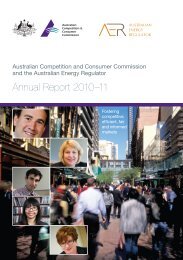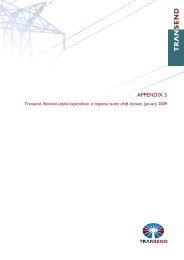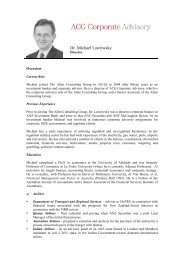Internal consistency of risk free rate and MRP in the CAPM
Internal consistency of risk free rate and MRP in the CAPM
Internal consistency of risk free rate and MRP in the CAPM
Create successful ePaper yourself
Turn your PDF publications into a flip-book with our unique Google optimized e-Paper software.
19. Material <strong>in</strong>creases <strong>in</strong> dem<strong>and</strong> for CGS from foreigners <strong>and</strong> <strong>the</strong> bank<strong>in</strong>g system can<br />
also be expected to raise this basel<strong>in</strong>e ‘scarcity premium’ for <strong>the</strong> foreseeable future.<br />
As noted by <strong>the</strong> RBA, foreign hold<strong>in</strong>gs <strong>of</strong> CGS have risen to 75% <strong>of</strong> <strong>the</strong> market <strong>in</strong><br />
recent months reflect<strong>in</strong>g, <strong>in</strong> part, <strong>the</strong> shr<strong>in</strong>k<strong>in</strong>g pool <strong>of</strong> AAA <strong>rate</strong>d sovereign debt due to<br />
downgrades <strong>of</strong> US debt <strong>in</strong> August 2011 <strong>and</strong>, most recently, French debt <strong>in</strong> January<br />
2012. Similarly, <strong>the</strong> RBA has po<strong>in</strong>ted to Basel III liquidity requirements as rais<strong>in</strong>g <strong>the</strong><br />
dem<strong>and</strong> for CGS (<strong>in</strong>deed, <strong>the</strong> pre-exist<strong>in</strong>g scarcity <strong>of</strong> CGS <strong>in</strong> Australia is an issue<br />
explicitly acknowledged <strong>in</strong> <strong>the</strong> development <strong>of</strong> Basel III).<br />
AER methodology not consistent with NGR 87(1)<br />
20. Based on <strong>the</strong> evidence summarised above, I conclude that <strong>the</strong> AER’s methodology is<br />
not valid <strong>in</strong> current market conditions. Specifically, <strong>the</strong> assumption, implicit <strong>in</strong> <strong>the</strong> AER<br />
methodology, that <strong>the</strong> cost <strong>of</strong> equity has moved one-for-one with CGS yields <strong>and</strong> is<br />
currently at historically low levels is <strong>in</strong>valid. Moreover, it is likely to be <strong>in</strong>valid <strong>in</strong> <strong>the</strong><br />
medium term due to supply <strong>and</strong> dem<strong>and</strong> dynamics <strong>in</strong> <strong>the</strong> market for CGS.<br />
Alternatives to <strong>the</strong> AER methodology<br />
21. I propose three alternatives to <strong>the</strong> AER’s methodology that implement <strong>the</strong> <strong>CAPM</strong>. I<br />
consider that each <strong>of</strong> <strong>the</strong>se methodologies would comply with Rule 87(1) <strong>of</strong> <strong>the</strong> NGR if<br />
applied <strong>in</strong> <strong>the</strong> current market circumstances. I do not consider that <strong>the</strong> same is true for<br />
<strong>the</strong> AER’s methodology. My three alternatives are:<br />
i. Directly estimat<strong>in</strong>g <strong>the</strong> prevail<strong>in</strong>g cost <strong>of</strong> equity for regulated utilities us<strong>in</strong>g <strong>the</strong><br />
dividend growth model (<strong>in</strong>volv<strong>in</strong>g a simultaneous estimate <strong>of</strong> all parameters <strong>of</strong> <strong>the</strong><br />
<strong>CAPM</strong>).<br />
ii. Directly estimat<strong>in</strong>g <strong>the</strong> prevail<strong>in</strong>g <strong>MRP</strong> relative to <strong>the</strong> prevail<strong>in</strong>g CGS yield be<strong>in</strong>g<br />
used as <strong>the</strong> <strong>risk</strong> <strong>free</strong> <strong>rate</strong>. This elim<strong>in</strong>ates potential for error from <strong>the</strong> AER’s<br />
methodology - <strong>in</strong> which <strong>the</strong>re is no attempt to estimate <strong>the</strong> <strong>MRP</strong> relative to <strong>the</strong><br />
prevail<strong>in</strong>g <strong>risk</strong> <strong>free</strong> <strong>rate</strong>. In this methodology <strong>the</strong> AER’s proposed value <strong>of</strong> 0.8 for<br />
beta is adopted.<br />
iii. Estimat<strong>in</strong>g a ‘normal’ cost <strong>of</strong> equity for regulated bus<strong>in</strong>esses by estimat<strong>in</strong>g each <strong>of</strong><br />
<strong>the</strong> <strong>CAPM</strong> parameters us<strong>in</strong>g suitable historical time periods. This provides a proxy<br />
for <strong>the</strong> prevail<strong>in</strong>g cost <strong>of</strong> equity if <strong>the</strong> prevail<strong>in</strong>g cost <strong>of</strong> equity is relatively stable over<br />
time (an assumption supported by <strong>the</strong> evidence <strong>in</strong> this report). It also provides a<br />
m<strong>in</strong>imum estimate <strong>of</strong> <strong>the</strong> cost <strong>of</strong> equity if one believes that current market<br />
conditions are such that <strong>the</strong> cost <strong>of</strong> equity is more likely above its long term average<br />
than below (a view that is supported by <strong>the</strong> evidence <strong>in</strong> this report). A departure<br />
from this historical norm could be justified if <strong>the</strong>re was some threshold level <strong>of</strong><br />
evidence to <strong>the</strong> effect that currently prevail<strong>in</strong>g market conditions were sufficiently<br />
different from <strong>the</strong> normal market conditions. Whe<strong>the</strong>r this threshold was satisfied<br />
could be assessed by, for example, application <strong>of</strong> methodologies i) <strong>and</strong> ii) above.<br />
22. In <strong>the</strong> table below (from section 6 <strong>of</strong> my report) I summarise <strong>the</strong> results <strong>of</strong> application<br />
<strong>of</strong> <strong>the</strong>se methodologies.<br />
Competition Economists Group<br />
www.CEG-AP.COM<br />
vi







